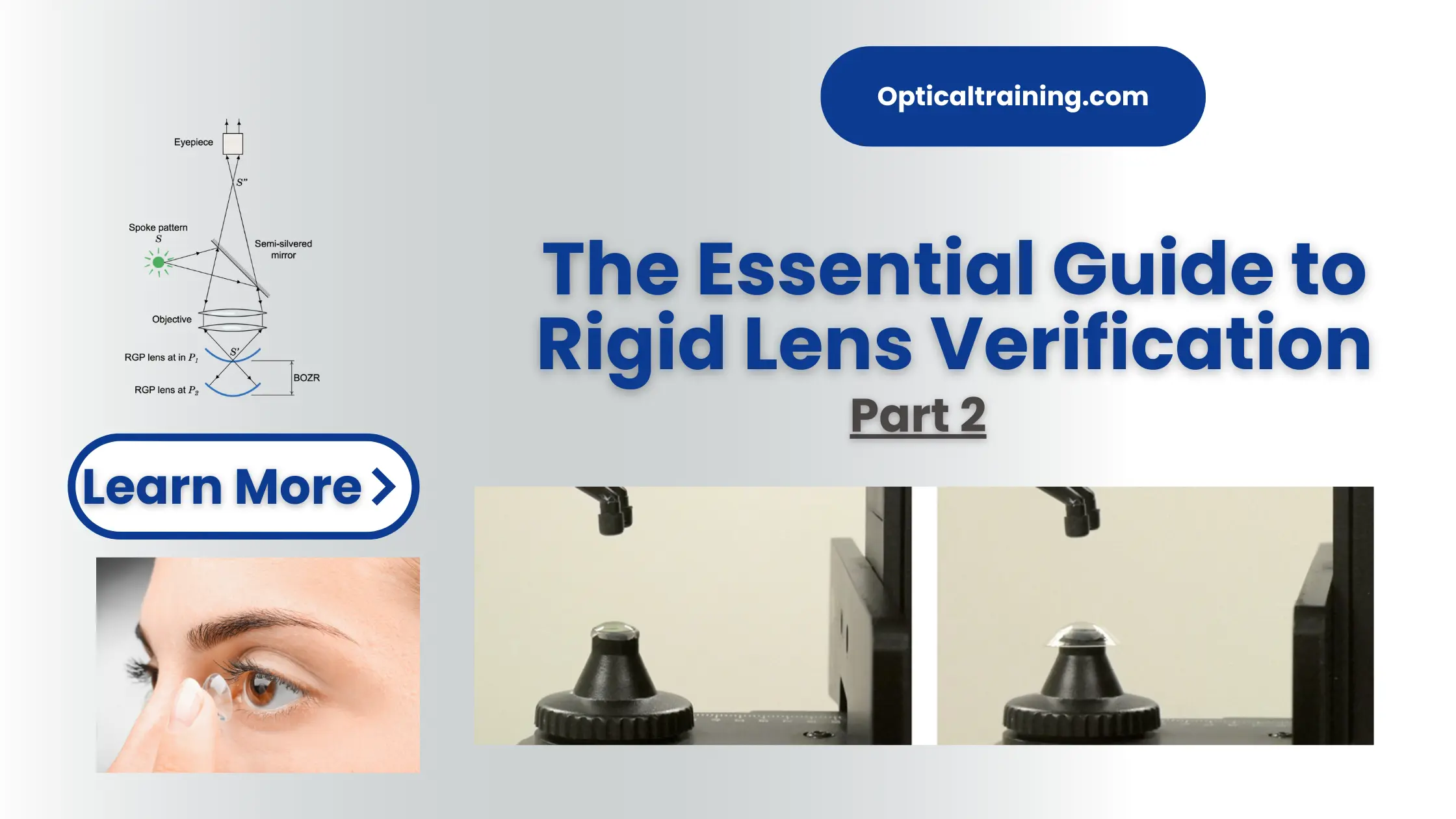
The Essential Guide to Rigid Lens Verification: Part 2
In part two of this comprehensive guide, we’ll walk you through the key steps for verifying RGP lenses, from measuring base curves to inspecting edge designs. We’ll cover the proper techniques and common pitfalls to avoid. Whether you’re new to fitting RGP lenses or looking to refine your verification process, you’ll find practical tips to ensure your patients receive lenses that meet their exact specifications.
For Part 1 click here
Preparing for Lens Verification
Before diving into the actual measurements, it’s important to properly prepare both your workspace and the lenses themselves. Taking a few minutes for setup will help ensure accurate and consistent results.
Creating an Ideal Verification Environment
First, choose a clean, well-lit area for your lens checks, preferably a dedicated station away from air vents or drafts that could affect delicate measurements.
Make sure you have all your tools and supplies within easy reach. This includes:
- Verification instruments
- Lens cases and solution
- Lint-free cloths or tissues
- Calibration tools if needed
Good lighting is crucial. A combination of overhead lighting and a movable task light to illuminate lenses from different angles is recommended.
Lens Preparation
Always start with clean, dry lenses. Even small amounts of debris or solution can throw off measurements. Below are the recommended steps:
- Remove lenses from their vials and gently clean with an approved RGP cleaner.
- Rinse thoroughly with saline solution.
- Carefully dry the lenses with a lint-free cloth or tissue.
- Allow lenses to equilibrate to room temperature for at least 15 minutes.
Some practitioners prefer to soak lenses in saline overnight before verification. While this isn’t strictly necessary for modern high-Dk materials, it can help ensure parameter stability.
Calibration Checks
Before measuring any lenses, take a moment to check the calibration of your instruments. Most verification tools come with calibration standards or test lenses.For example, you can verify radiuscope readings with a set of stainless steel balls of known radii. Similarly, you can check the lensometer against a calibration lens to ensure accurate power measurements. Regular calibration checks help catch any drift in your instruments over time. It’s a small step that can prevent big headaches down the line.
Documentation
Set up a system to record your verification results. Whether you use paper forms or digital records, having a consistent method helps track any discrepancies or trends over time.
Keeping a verification log for each batch of lenses is encouraged. This log should note:
- Date of verification
- Lens details (manufacturer, material, parameters)
- Measured values for each parameter
- Any deviations from specified values
- Actions taken (accepted, rejected, sent for remake)
This documentation can be invaluable if questions arise later about a particular lens or fitting.
By taking the time to create an organized, calibrated verification setup, you’ll be well-positioned to accurately assess your RGP lenses.
In the next section, we’ll dive into the specific techniques for measuring key lens parameters.
Verifying Back Optic Zone Radius (BOZR)
The back optic zone radius, or base curve, is arguably the most critical parameter to verify on an RGP lens. It directly impacts the lens-to-cornea fitting relationship and can significantly affect comfort, vision, and ocular health.
Using a Radiuscope
The radiuscope is the gold standard for BOZR measurement. Here’s how to use it effectively:
- Place the lens concave side up on the appropriate lens mount.
- Add a small drop of saline to the front surface to neutralize reflections.
- Adjust the microscope to focus on the lens surface, creating a clear image of the illuminated target (usually a spoke pattern).
- Set the measuring scale to zero at this position.
- Slowly move the lens towards the microscope until a second clear image appears. This represents the center of curvature.
- Read the displacement on the scale – this is your BOZR measurement.
For best results, take at least three readings and average them. Be aware that very small or large BOZRs can be more challenging to measure accurately.
Keratometer Method
If you don’t have a radiuscope, a keratometer can provide a reasonable BOZR estimate:
- Attach a contact lens holder to your keratometer’s headrest.
- Place the lens concave side out, with the front surface resting on a drop of saline in the holder.
- Focus the mires as you would for a normal keratometry reading.
- Take readings in two meridians and average them.
- Add a small correction factor (typically +0.03mm) to account for the concave surface.
While not as precise as a radiuscope, this method can give you a good approximation of BOZR.
Topographer Technique
For practices with a corneal topographer, this can be an excellent tool for assessing BOZR and overall back surface geometry:
- Use a special lens holder designed for your topographer.
- Position the lens concave side out, neutralizing the front surface with saline.
- Capture an image following your topographer’s standard protocol.
- Analyze the resulting map, paying attention to the central BOZR value and any aspheric or toric features.
Topography is especially useful for complex lens designs like orthokeratology or scleral lenses.
Tips for Accurate BOZR Measurement
- Always measure dry, clean lenses at room temperature.
- Be consistent in your technique – small variations can lead to significant differences.
- For toric lenses, measure both principal meridians separately.
- Pay attention to the size of the back optic zone – very small zones can be challenging to measure accurately.
- Consider the lens material – some highly oxygen-permeable materials may show slight parameter changes over time.
Measuring Lens Diameters and Thicknesses
Accurate measurement of lens diameters and thicknesses is crucial for ensuring proper fit, centration, and oxygen transmission. Let’s explore the best techniques for verifying these important parameters.
Total Diameter Verification
The total diameter of an RGP lens affects its overall fitting characteristics and interaction with the eyelids. Here are three methods for checking diameter:
Using a V-Gauge
- Place the dry lens concave side down in the V-shaped channel.
- Gently tilt the gauge to allow the lens to slide to its widest point.
- Read the diameter directly from the scale where the lens edges align.
While quick and easy, the V-gauge is less precise than other methods.
Measuring Magnifier Technique
- Position the lens on a flat surface under the magnifier.
- Align one edge of the lens with a major scale division.
- Count the divisions to the opposite edge.
- Multiply by the scale factor (usually 0.1mm per division) to get the diameter.
This method offers good precision but requires a steady hand and good lighting.
Projection Magnifier Method
- Place the lens in the holder of your projection magnifier.
- Focus the image on the calibrated screen.
- Align one edge with a major division and measure to the opposite edge.
- Read the diameter directly from the scale.
Projection magnifiers offer excellent precision and ease of use, especially for high-volume practices.
Center Thickness Measurement
Accurate center thickness is vital, especially for higher-powered lenses where oxygen transmission can be a concern. Here are two common methods:
Using a Thickness Gauge
- Zero the gauge with the probe fully retracted.
- Gently lower the probe onto the center of the lens.
- Read the thickness directly from the gauge display.
Digital gauges often offer the highest precision, but analog versions can work well with practice.
Radiuscope Method
Some radiuscopes have a built-in thickness measurement feature:
- Focus on the front surface of the lens and zero the scale.
- Refocus on the back surface.
- Multiply the scale reading by the refractive index of the lens material to get the true thickness.
This method can be very precise but requires careful technique.
Tips for Accurate Diameter and Thickness Measurements
- Always measure clean, dry lenses at room temperature.
- Take multiple readings and average them for best accuracy.
- Be aware of the tolerance ranges: ±0.10mm for diameter and ±0.02mm for center thickness in most cases.
- For toric or multifocal lenses, measure thickness at multiple points across the lens.
- Consider the lens power when assessing thickness – minus lenses will be thinnest at the center, while plus lenses will be thickest.
By mastering these techniques, you’ll be able to quickly and accurately verify the physical dimensions of your RGP lenses.
Verifying Lens Power and Optical Quality
Ensuring the correct power and optical quality of RGP lenses is crucial for providing patients with optimal vision. Let’s explore the best methods for verifying these important aspects.
Measuring Back Vertex Power
The most common method for checking RGP lens power is using a lensometer (focimeter). Here’s how to get accurate readings:
- Use a special small-aperture stop designed for contact lenses.
- Position the lens concave side down on the lens stop.
- Focus the mires as you would for a spectacle lens.
- Read the power directly from the instrument.
For best results:
- Take multiple readings and average them.
- Be aware that high-powered lenses may require a vertex distance correction.
- For multifocal lenses, measure power in different zones as specified by the manufacturer.
Assessing Optical Quality
Beyond just measuring power, it’s important to evaluate the overall optical quality of the lens. Here are some key aspects to check:
Surface Regularity
Use a slit lamp to examine the lens surfaces:
- Start with low magnification and diffuse illumination to get an overall view.
- Switch to higher magnification and a narrow slit beam to check for any irregularities or defects.
Look for:
- Smooth, even surfaces without scratches or pits
- Consistent reflection of the slit beam across the lens
Warpage Check
Lens warpage can cause vision problems and poor fits. To check:
- Place the lens concave side down on a flat surface.
- Gently press the center with a cotton swab.
- Look for any rocking motion or edge lift.
Significant warpage may require lens replacement.
Power Map (for Complex Designs)
For multifocal or custom lens designs, a power map can be helpful:
- Use a corneal topographer with contact lens mapping capabilities.
- Follow the manufacturer’s protocol for lens positioning.
- Analyze the resulting power map to ensure it matches the intended design.
This is especially useful for verifying progressive or aspheric lens designs.
Tips for Power and Optical Quality Verification
- Always clean and dry lenses thoroughly before measuring.
- Be aware of the power tolerance ranges, which vary based on lens strength.
- For toric lenses, measure power in both principal meridians.
- Consider the optic zone size when measuring power – very small optic zones may give inaccurate readings.
- Pay special attention to the optical quality of high-powered lenses, as they’re more prone to aberrations.
By carefully verifying both power and optical quality, you can ensure your patients receive lenses that provide crisp, clear vision. With the techniques outlined in this blog, you’ll be well-prepared to deliver the perfect lens fit every time.
Ready to take your optical knowledge to the next level? Stay updated with the latest industry trends, news, and updates by joining our email newsletter. Don’t miss out—subscribe today and stay ahead in your optical career!



